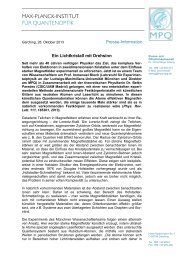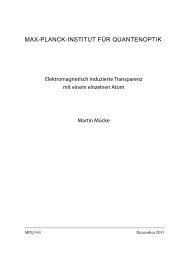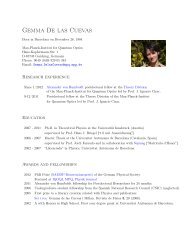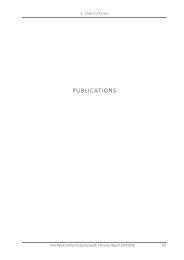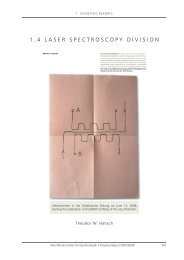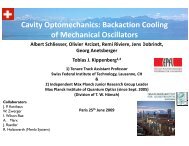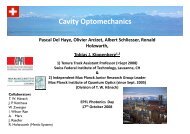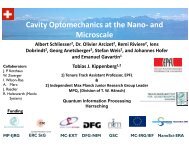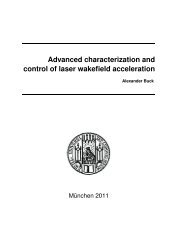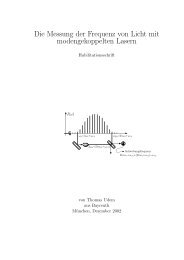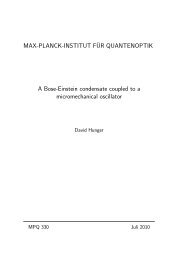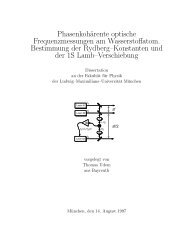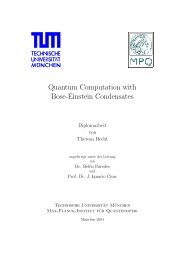Attosecond Control and Measurement: Lightwave Electronics
Attosecond Control and Measurement: Lightwave Electronics
Attosecond Control and Measurement: Lightwave Electronics
You also want an ePaper? Increase the reach of your titles
YUMPU automatically turns print PDFs into web optimized ePapers that Google loves.
772<br />
<strong>Attosecond</strong> Spectroscopy<br />
pulse is both versatile <strong>and</strong> sufficiently compact<br />
<strong>and</strong> affordable to allow proliferation in small<br />
laboratories. The core infrastructure required is<br />
sketched in Fig. 2. The scope of the technology<br />
largely depends on the characteristics <strong>and</strong> flexibility<br />
of its key tools: synthesized fields of laser<br />
light <strong>and</strong> attosecond pulses synchronized to them.<br />
From <strong>Control</strong>led Light Waveforms Toward Optical<br />
Waveform Synthesis<br />
<strong>Lightwave</strong> electronics benefits from ever-broader<br />
optical b<strong>and</strong>width in several ways. Superposition<br />
of spectral components beyond an octave permits<br />
subcycle shaping of the light waveform<br />
<strong>and</strong> hence sculpting of the electric force on the<br />
electronic time scale for steering electrons in<br />
atomic systems. The increased b<strong>and</strong>width <strong>and</strong><br />
improved dispersion control also lead to shorter<br />
optical pulses, which allow advancing subfemtosecond<br />
XUV pulse generation<br />
in terms of all relevant parameters:<br />
duration, intensity, <strong>and</strong> photon<br />
energy.<br />
Intense few-cycle optical<br />
pulses (~5 fs) were first generated<br />
(40) by spectral broadening of<br />
femtosecond pulses (initially ~25<br />
fs) in a hollow-core waveguide,<br />
<strong>and</strong> the resultant supercontinuum<br />
was compressed by reflection off<br />
of chirped multilayer dielectric<br />
mirrors (41) (Fig. 3A). Combined<br />
with waveform control (4), the<br />
technology matured to become a<br />
workhorse for attosecond science.<br />
Its current state is represented by<br />
the results summarized in Fig. 3, B<br />
<strong>and</strong> C. The spectrum of near–20-fs,<br />
800-nm pulses is first broadened<br />
by self-phase modulation in a gasfilled<br />
capillary to a supercontin-<br />
uum reaching from 400 to 1000<br />
nm, followed by compression of<br />
the ~ 400-μJ pulses to ~3.5 fs<br />
with octave-spanning chirped mirrors<br />
(42). These pulses constitute<br />
the shortest controlled optical<br />
waveforms demonstrated to date.<br />
Figure 3D shows how a<br />
single subfemtosecond XUV<br />
pulse can emerge from an atom<br />
ionized by a linearly polarized<br />
few-cycle light field. The green<br />
lines depict the kinetic energy,<br />
W kin, with which different portions<br />
of the freed electron wave packet (y free in<br />
Fig. 1B) return to the core as a function of return<br />
time, determining the energy of the emitted<br />
harmonic photon, ħw = Wkin + Wb, where Wb is<br />
the binding energy of the electron. For the<br />
optimum (near-cosine) waveform (Fig. 3D), we<br />
can estimate—in the limit of ħw X >> W b—the<br />
b<strong>and</strong>width over which photons of the highest<br />
1 . 3 AT T O S E C O N D A N D H I G H - F I E L D P H Y S I C S D I V I S I O N<br />
energy (near the cutoff of the emitted spectrum<br />
depicted in violet) are emitted from one recollision<br />
only as<br />
DWsingle�pulse<br />
176 Max-Planck-Institut für Quantenoptik • Progress Report 2007/2008<br />
ℏwX<br />
≈ 0:6<br />
Tosc<br />
TFWHM<br />
2<br />
ð1Þ<br />
where T osc <strong>and</strong> T FWHM st<strong>and</strong> for the oscillation<br />
period (osc) of the carrier wave <strong>and</strong> the full width<br />
at half maximum (FWHM) duration of the<br />
laser pulse ionizing the atoms, respectively<br />
(43). Equation 1 underscores the importance of<br />
minimizing the number of cycles within the<br />
driver pulse. The intense sub–1.5 cycle (TFWHM<br />
< 1.5Tosc) laser pulses that can now be produced<br />
with commercially available ingredients of ultrafast<br />
laser technology (Fig. 3, A to C) constitute a<br />
promising tool for pushing the frontiers of<br />
attosecond-pulse technology.<br />
Advancing femtosecond technology to its<br />
ultimate limit is the key to extending the frontiers<br />
of both measuring <strong>and</strong> controlling dynamics with<br />
attosecond precision. Metrology benefits from<br />
broader spectral coverage <strong>and</strong> shorter duration of<br />
subfemtosecond pulses. The scope of control critically<br />
depends on the variety of waveforms, which<br />
is determined by the available b<strong>and</strong>width of intense<br />
coherent radiation. The shortest intense laser pulses<br />
also provide ideal conditions for generating the<br />
broadest supercontinua of coherent light, extending<br />
over more then three octaves (44). Advanced<br />
chirped multilayer mirror technology holds promise<br />
for versatile <strong>and</strong> scalable (multichannel) implementation<br />
of optical waveform synthesis. A<br />
prototypical three-channel synthesizer operational<br />
over the 1- to 3-eV b<strong>and</strong> indicates the vast variety<br />
of possibilities for steering electrons in atomic<br />
systems with synthesized optical waves (fig. S2).<br />
From Subfemtosecond Toward<br />
<strong>Attosecond</strong> Pulses<br />
Equation 1 suggests that femtosecond technology<br />
must approach the monocycle limit to push the<br />
frontiers of XUV pulse generation toward <strong>and</strong><br />
below 100 as. However, there are other options.<br />
Modulation of the polarization state of the ioniz-<br />
Fig. 2. Schematic of an experimental setup for attosecond-pulse generation <strong>and</strong> attosecond metrology as well as<br />
spectroscopy: the AS-1 attosecond beamline at MPQ. The intense, waveform-controlled few-cycle NIR laser pulse<br />
generates a subfemtosecond XUV pulse in the first interaction medium (jet of noble gas). The collinear XUV <strong>and</strong> NIR<br />
beams then propagate into a second vacuum chamber, where they are focused by a two-component XUV multilayer<br />
mirror into a gas target. The inner <strong>and</strong> outer part of the two-component mirror reflects <strong>and</strong> focuses the XUV <strong>and</strong> the<br />
(more divergent) NIR beam, respectively. By positioning the internal mirror with a nanometer-precision piezotranslator,<br />
the XUV pulse can be delayed with respect to the NIR pulse with attosecond accuracy. Analysis of the generated<br />
electrons <strong>and</strong>/or ions as a function of delay between the subfemtosecond XUV <strong>and</strong> the waveform-controlled NIR pulse<br />
permits characterization of the attosecond tools (Fig. 1) as well as real-time observation of atomic-scale electron<br />
dynamics in all forms of matter by means of attosecond streaking spectroscopy (3) <strong>and</strong> attosecond tunneling<br />
spectroscopy (13) with the same apparatus. In the former case, the final energy distribution of the outgoing electron is<br />
analyzed with a time-of-flight spectrometer; in the latter case, the observables measured as a function of delay are<br />
multiple-charged ions. ACF, auto-correlation function; CCD, charged-coupled device.<br />
10 AUGUST 2007 VOL 317 SCIENCE www.sciencemag.org<br />
ing NIR pulse (33, 37, 45) or of its amplitude by<br />
coherent addition of second harmonic radiation<br />
(46, 47) can efficiently increase DWsingle-pulse<br />
even by using several-cycle NIR driver pulses.<br />
Implementation of polarization gating with<br />
waveform-controlled, approximately two-cycle<br />
NIR pulses (37) has recently led to a spectacular<br />
achievement: the generation of isolated XUV<br />
on November 12, 2007<br />
www.sciencemag.org<br />
Downloaded from



